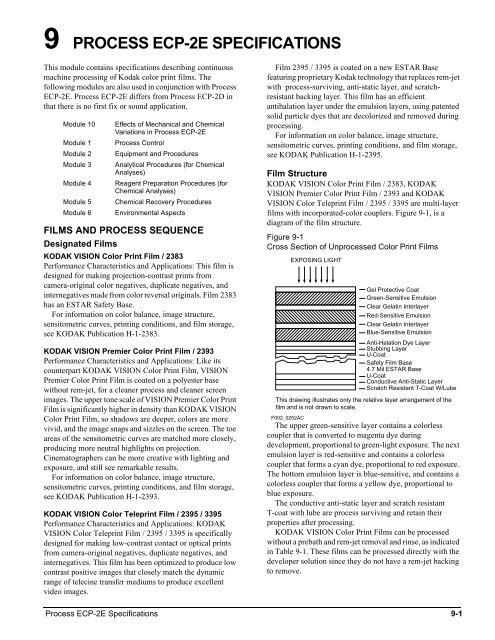Process ECP-2E Specifications - Kodak
Process ECP-2E Specifications - Kodak
Process ECP-2E Specifications - Kodak
Create successful ePaper yourself
Turn your PDF publications into a flip-book with our unique Google optimized e-Paper software.
9 PROCESS <strong>ECP</strong>-<strong>2E</strong> SPECIFICATIONS<br />
This module contains specifications describing continuous<br />
machine processing of <strong>Kodak</strong> color print films. The<br />
following modules are also used in conjunction with <strong>Process</strong><br />
<strong>ECP</strong>-<strong>2E</strong>. <strong>Process</strong> <strong>ECP</strong>-<strong>2E</strong> differs from <strong>Process</strong> <strong>ECP</strong>-2D in<br />
that there is no first fix or sound application.<br />
Module 10 Effects of Mechanical and Chemical<br />
Variations in <strong>Process</strong> <strong>ECP</strong>-<strong>2E</strong><br />
Module 1 <strong>Process</strong> Control<br />
Module 2 Equipment and Procedures<br />
Module 3 Analytical Procedures (for Chemical<br />
Analyses)<br />
Module 4 Reagent Preparation Procedures (for<br />
Chemical Analyses)<br />
Module 5 Chemical Recovery Procedures<br />
Module 6 Environmental Aspects<br />
FILMS AND PROCESS SEQUENCE<br />
Designated Films<br />
KODAK VISION Color Print Film / 2383<br />
Performance Characteristics and Applications: This film is<br />
designed for making projection-contrast prints from<br />
camera-original color negatives, duplicate negatives, and<br />
internegatives made from color reversal originals. Film 2383<br />
has an ESTAR Safety Base.<br />
For information on color balance, image structure,<br />
sensitometric curves, printing conditions, and film storage,<br />
see KODAK Publication H-1-2383.<br />
KODAK VISION Premier Color Print Film / 2393<br />
Performance Characteristics and Applications: Like its<br />
counterpart KODAK VISION Color Print Film, VISION<br />
Premier Color Print Film is coated on a polyester base<br />
without rem-jet, for a cleaner process and cleaner screen<br />
images. The upper tone scale of VISION Premier Color Print<br />
Film is significantly higher in density than KODAK VISION<br />
Color Print Film, so shadows are deeper, colors are more<br />
vivid, and the image snaps and sizzles on the screen. The toe<br />
areas of the sensitometric curves are matched more closely,<br />
producing more neutral highlights on projection.<br />
Cinematographers can be more creative with lighting and<br />
exposure, and still see remarkable results.<br />
For information on color balance, image structure,<br />
sensitometric curves, printing conditions, and film storage,<br />
see KODAK Publication H-1-2393.<br />
KODAK VISION Color Teleprint Film / 2395 / 3395<br />
Performance Characteristics and Applications: KODAK<br />
VISION Color Teleprint Film / 2395 / 3395 is specifically<br />
designed for making low-contrast contact or optical prints<br />
from camera-original negatives, duplicate negatives, and<br />
internegatives. This film has been optimized to produce low<br />
contrast positive images that closely match the dynamic<br />
range of telecine transfer mediums to produce excellent<br />
video images.<br />
Film 2395 / 3395 is coated on a new ESTAR Base<br />
featuring proprietary <strong>Kodak</strong> technology that replaces rem-jet<br />
with process-surviving, anti-static layer, and scratchresistant<br />
backing layer. This film has an efficient<br />
antihalation layer under the emulsion layers, using patented<br />
solid particle dyes that are decolorized and removed during<br />
processing.<br />
For information on color balance, image structure,<br />
sensitometric curves, printing conditions, and film storage,<br />
see KODAK Publication H-1-2395.<br />
Film Structure<br />
KODAK VISION Color Print Film / 2383, KODAK<br />
VISION Premier Color Print Film / 2393 and KODAK<br />
VISION Color Teleprint Film / 2395 / 3395 are multi-layer<br />
films with incorporated-color couplers. Figure 9-1, is a<br />
diagram of the film structure.<br />
Figure 9-1<br />
Cross Section of Unprocessed Color Print Films<br />
EXPOSING LIGHT<br />
Gel Protective Coat<br />
Green-Sensitive Emulsion<br />
Clear Gelatin Interlayer<br />
Red-Sensitive Emulsion<br />
Clear Gelatin Interlayer<br />
Blue-Sensitive Emulsion<br />
Anti-Halation Dye Layer<br />
Stubbing Layer<br />
U-Coat<br />
Safety Film Base<br />
4.7 Mil ESTAR Base<br />
U-Coat<br />
Conductive Anti-Static Layer<br />
Scratch Resistant T-Coat W/Lube<br />
This drawing illustrates only the relative layer arrangement of the<br />
film and is not drawn to scale.<br />
F002_0252AC<br />
The upper green-sensitive layer contains a colorless<br />
coupler that is converted to magenta dye during<br />
development, proportional to green-light exposure. The next<br />
emulsion layer is red-sensitive and contains a colorless<br />
coupler that forms a cyan dye, proportional to red exposure.<br />
The bottom emulsion layer is blue-sensitive, and contains a<br />
colorless coupler that forms a yellow dye, proportional to<br />
blue exposure.<br />
The conductive anti-static layer and scratch resistant<br />
T-coat with lube are process surviving and retain their<br />
properties after processing.<br />
KODAK VISION Color Print Films can be processed<br />
without a prebath and rem-jet removal and rinse, as indicated<br />
in Table 9-1. These films can be processed directly with the<br />
developer solution since they do not have a rem-jet backing<br />
to remove.<br />
<strong>Process</strong> <strong>ECP</strong>-<strong>2E</strong> <strong>Specifications</strong> 9-1
















